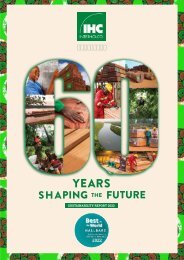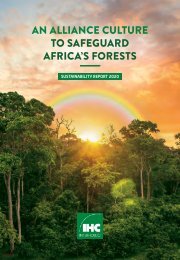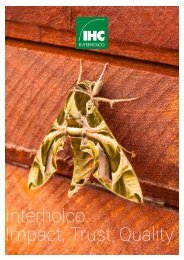Nomenclature Générale des Bois Tropicaux - 7ème édition
(english description below) Cette nomenclature est utilisée pour la mise à jour du 'Harmonized Code System' de l’Organisation Mondiale des Douanes. Dans la circulaire du 5 avril 2005, le Ministère de l’Economie, des Finances et de l’Industrie (France) reconnaît l’ATIBT comme « gardien du temple » de la nomenclature des bois tropicaux. La Commission Européenne mentionne la nomenclature de l’ATIBT comme document de référence pour la mise en œuvre du RBUE. Depuis 1954, l’ATIBT a établi et mis à jour une nomenclature des bois tropicaux faisant correspondre chaque espèce botanique avec un nom pilote reconnu internationalement. La détermination du nom pilote d’une essence est cruciale, car sa commercialisation dépend très largement de l’adoption de ce nom par le public. Le nom pilote assure la protection de l’appellation commerciale de l’essence et l’intégrité des propriétés qui lui sont attribuées, sans risque de confusion. The 1982 version of the general timber nomenclature has finally been updated as some of the 1,750 identified species, are no longer traded, while others, which were not previously included, are now on the market. The present revision has also integrated changes related to new taxonomy, in order to reflect the latest scientific developments. This Nomenclature has been used for the Harmonized Code System, updated by the World Customs Organization. The French Ministry of economy, finance and industry has given official recognition to ATIBT as the reference for the tropical timber nomenclature (NOR: PRMX0508285C of April 5th 2005). The European Commission refers to ATIBT nomenclature as a reference document for the implementation of the EUTR regulation. Since 1954, ATIBT has established and updated a nomenclature of tropical wood, linking each botanical species with an internationally recognized pilot name. A sigle wood species may have many common names; when trading across different countries, this may lead to confusion. Fixing the pilot name of a timber species is crucial, to protect the commercial denomination of the species and guarantee the veracity of the properties linked to that species, without confusion.
(english description below)
Cette nomenclature est utilisée pour la mise à jour du 'Harmonized Code System' de l’Organisation Mondiale des Douanes. Dans la circulaire du 5 avril 2005, le Ministère de l’Economie, des Finances et de l’Industrie (France) reconnaît l’ATIBT comme « gardien du temple » de la nomenclature des bois tropicaux. La Commission Européenne mentionne la nomenclature de l’ATIBT comme document de référence pour la mise en œuvre du RBUE.
Depuis 1954, l’ATIBT a établi et mis à jour une nomenclature des bois tropicaux faisant correspondre chaque espèce botanique avec un nom pilote reconnu internationalement. La détermination du nom pilote d’une essence est cruciale, car sa commercialisation dépend très largement de l’adoption de ce nom par le public. Le nom pilote assure la protection de l’appellation commerciale de l’essence et l’intégrité des propriétés qui lui sont attribuées, sans risque de confusion.
The 1982 version of the general timber nomenclature has finally been updated as some of the 1,750 identified species, are no longer traded, while others, which were not previously included, are now on the market. The present revision has also integrated changes related to new taxonomy, in order to reflect the latest scientific developments.
This Nomenclature has been used for the Harmonized Code System, updated by the World Customs Organization. The French Ministry of economy, finance and industry has given official recognition to ATIBT as the reference for the tropical timber nomenclature (NOR: PRMX0508285C of April 5th 2005). The European Commission refers to ATIBT nomenclature as a reference document for the implementation of the EUTR regulation.
Since 1954, ATIBT has established and updated a nomenclature of tropical wood, linking each botanical species with an internationally recognized pilot name. A sigle wood species may have many common names; when trading across different countries, this may lead to confusion. Fixing the pilot name of a timber species is crucial, to protect the commercial denomination of the species and guarantee the veracity of the properties linked to that species, without confusion.
Create successful ePaper yourself
Turn your PDF publications into a flip-book with our unique Google optimized e-Paper software.
84 ///
Nomenclature générale des bois tropicaux 2016
PILOT NAME BOTANICAL NAMES COMMON NAMES
Rosewood, Sonokeling
Dalbergia latifolia Roxb.
Rosewood, Tamalan Dalbergia oliveri Gamb.
Rosewood, Violete
Sabicu
Saboarana
Safukala
Sal
Dalbergia cearensis Ducke
Lysiloma latisiliquum Benth.
Swartzia benthamiana Miq.
Swartzia euxylophora Rizzini & A. Mattos
Swartzia laevicarpa Amsh
Swartzia p.p.
Dacryodes heterotricha H.J. Lam
Dacryodes pubescens H.J. Lam
(Syn. Pachylobus pubescens)
Shorea obtusa Wall.
Shorea robusta Gaertn.
Indian Rosewood (IN) ; Sonokeling (ID)
Ching Chan (TH) ; Tamalan (MM)
Gum, Saligna Eucalyptus saligna Sm. Saligna Gum (AU)
Salimuli
Samak
Cordia dichotoma J.R. Forst. & G. Forst.
Cordia fragrantissima Kurz
Cordia subcordata
Cordia p.p. (AS)
Adinandra spp.
Gordonia excelsa Blume
Gordonia multinervis King
Gordonia spp.
Schima wallichii Korth.
(Syn. Schima noronhae)
Schima spp.
Sandalwood Santalum album L.
Sandé
Brosimum potabile Ducke
Brosimum utile Pitt.
Brosimum spp.
Jacaranda cega machado (BR) ; Jacaranda violeta
(BR) ; Miolo de negro (BR) ; Pau violeta (BR) ; Violete
(BR)
False Tamarind (JM) ; Sabicu (BS, PR) ; Salam (MX) ;
Tavernon (HT) ; Tzalam (DO)
Arruda vermelha (BR) ; Itikiborobali (GY) ; Montouchi
savane (GF) ; Saboarana (BR)
M’Bidinkala (CD) ; Mouganga (GA) ; Mouguengueri
(CD) ; N’Safu-Nkala (CD) ; Safoukala (AO, CG) ;
Safucala (AO, CG)
Burma Sal (MM) ; Ca-Chac (VN) ; Chan (TH) ;
Hang (MY) ; Pao (TH) ; Phchek (KH) ; Sal (IN) ;
Teng-Rang (TH) ; Thitya (MM, MY)
Island Walnut (PG) ; Salimuli (ID) ; Sandawa (MM)
Chilauni (ID) ; Mang-Tan (TH) ; Puspa (ID) ; Samak
(MY) ; Ta-lo (TH)
Bachdan (VN) ; Sandalwood (IN) ; Santal (MY) ;
Tjendana (ID)
Amapa (BR) ; Amapa doce (BR) ; Arbol vaca (CO) ;
Dokali (GF) ; Guaimaro (CO) ; Lechero (CO) ;
Leiteira (BR) ; Marina (VE) ; Palo de vaca (CR, PA) ;
Panguana (PE) ; Sande (CO, EC, VE) ; Sandy (PA) ;
Takina (GF) ; Vaca (VE)
San-Mu Cunninghamia lanceolata Hook. Koyo-San (JP) ; San-Mu (CN)
Sapelli
Sapucaia
Saqui-Saqui
Entandrophragma cylindricum Sprague
Lecythis spp.
Pachira quinata W.S. Alverson
(Syn. Bombacopsis quinata)
Eriotheca globosa A. Robyns
(Syn. Bombax globosum)
Aboudikro (CI) ; Assié-Sapelli (CM) ; Lifaki (CD) ;
M’Boyo (CF) ; Muyovu (UG) ; Penkwa (GH) ; Sapele
(NG) ; Sapelewood (GH) ; Sapelli (CM) ; Undianuno
(AO, CG, GA)
Canari Macaque (GF) ; Castanha Sapucaia (BR) ;
Coco cristal (CO) ; Coco de mono (VE) ; Coco mono
(CO) ; Guabillo (EC) ; Kouatapatoe (SR) ; Kouatapatou
(GF) ; Machin Mango (PE) ; Maho jaune (GF) ;
Monkey Pot (GY) ; Olla de mono (VE) ; Sapucaia
(BR) ; Sapucaia vermelha (BR) ; Tobago (GY) ; Wadaduri
(GY) ; Yunjua (EC)
Saqui-Saqui (VE)














